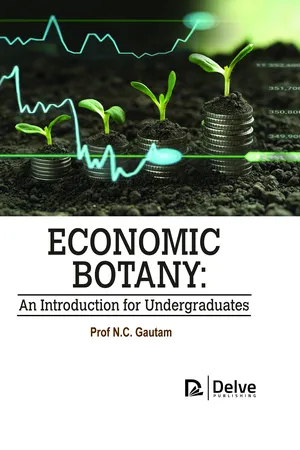
- 229 pages
- English
- PDF
- Only available on web
Economic botany: An introduction for undergraduates
About This Book
This book contains the most up-to-date data on the most important crops grown in various regions. Extensive discussion is given to the origins of agriculture, the evolution of agricultural plants, the discovery of plants, the migration of plants, the domestication of plants, and the proliferation of plants. Following a study of the ancestry and diversification of cultivated plants, we turn to a review of tropical, subtropical, and temperate crops used for food, beverages, spices, and medicines, as well as plant insecticides, timber plants, and essential oil-producing plants. Products from these crops range from food and drink to spices and even medicine. Plants that are used to make essential oils are also discussed. The beneficial impacts of a number of plants are examined in light of their unique genetic and evolutionary properties. Commercially important subtropical and temperate plants, as well as petro-crops, ethnobotanical studies, and biodiversity conservation, are discussed in this volume. The most important plant species belonging to each group are identified, and their significance is discussed at length. This book is an excellent resource for students of botany, food science, nutrition, forestry, agriculture, horticulture, plant breeding, and environmental science. One of the book's strongest selling qualities is that it was written by a person who has devoted their entire life to the field of economic botany. Extensive photographs and line drawings are provided, all of which include descriptive captions.
Frequently asked questions
Information
Table of contents
- Cover
- HalfTitle Page
- Title Page
- Copyright
- About the Author
- Table of Contents
- List of Figures
- Abstract
- Preface
- Chapter 1: Branches of Economic Botany
- Chapter 2: The Relationship Between Plants and People: Past, Present, and Potential Uses of Plants
- Chapter 3: Pure and Applied Botany
- Chapter 4: Crop Protection in Agriculture
- Chapter 5: Growing Techniques to Help Farmers increase Crop Yield
- Chapter 6: Genetic and Evolutionary Aspects of Different Plants and Their Health Benefits
- Chapter 7: Economic Benefits of Planting Trees
- Chapter 8: Commodity Groups of Food and Other Economic Crops
- Chapter 9: Modern Food Processing Technologies
- Chapter 10: Challenges to Botanical Sciences and Existing Opportunities
- References
- Index
- Back Cover